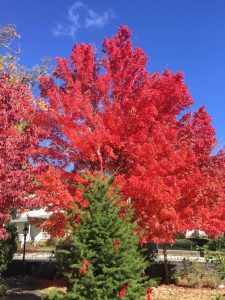Fall Colors
Fall has deep meaning for gardeners; first and foremost, it is the best planting time and second, fall gardens can be spectacularly colorful. Great gardens will produce color, texture, and interest all year round.
As the days shorten, the temperatures drop, and moisture increases. The plants begin to stop producing green pigment, or chlorophyll. The chlorophyll begins to decrease then stops all together. As the green pigment vacates the leaves, the red, orange, and yellow pigment remains. Yellow coloring comes from the pigment that creates sugars for chlorophyll. Red fall color is based on anthocyanins. Increased acidity in the soil or plants cause increased red fall coloring. As winter moves in, the green pigment breaks down and the fall oranges, yellows, and reds remain behind. Fall colors change, to a degree, depending on the weather and the moisture level. Fall color may be different year to year, but each fall-reacting plant always will produce color, just with varying intensity.
Adding fall color into your yard may be done with a wide variety of plants, ranging from annuals to shrubs to trees. Just as in the spring, the ground needs to be prepared, adding compost, and removing weeds. The best way to choose fall color is to see the plants as they are changing. September and October are great times to see the changes and to plant new additions to your yard. Fall is the number one root growing time of year, plus it is cooler for the transition from pot to ground. Shopping for fall color is best done in early fall prior to the leaves falling off.
One of the champions of fall color is Burning Bush or Euonymus alatus. There are several varieties that differ in size, but they all have one thing in common, flame red fall colors. Smoke bush or smoke tree is another scene stealer. Spring flowers appear as “smoke” or mist around the plant. Colors go from the spring purple to fall coral, orange, and red depending on the variety. Nandina starts with great colors and interesting texture, then changes to purple and bronze in the fall and bright crimson in the winter. Color comes in many forms including bright purple berries on the beautyberry or callicarpa. In summer the beauty berry has small pink to lilac flowers and in the winter has violet to purple fruit or berries. The bright purple clusters of berries are eye catching and unique.
The king of fall color in trees is the Japanese maple or Acer palmatum. Japanese maples come in a variety of sizes, leaf pattern, and colors. The reds, oranges, and yellows of Japanese maples are as intense as a solar flare. The red-twigged Sango Kaku has bright yellow leaves in the fall against red branching in the winter. The red Fireglow, when backlit by the fall sun, looks like red Christmas lights. Choice after choice in Japanese maples will provide unmatched fall color. Other fall-colored trees include Acer rubrums like Autumn Blaze, October Glory, and Red Sunset. These are fast growing with amazing scarlet fall color especially in frosty areas.
The Gingko biloba is a tree that has survived from prehistoric times. The golden fall color is like a gold coin. Remember to purchase only males since the berries are notoriously foul smelling.
Fall is an amazing time of year. The air is different. The colors are intense. Flowers change and vegetable gardens move from tomatoes to onions. Fall colors are like a gift from Mother Nature just for surviving through the baking summer. Enjoy the colors.
Julie Silva is a University of California Cooperative Extension Master Gardener of Tuolumne County.
UCCE Master Gardeners of Tuolumne and Calaveras Counties can answer home gardening questions. Call 209-533-5912 or to fill out our easy-to-use problem questionnaire here. Check out our website here, You can also find us on Facebook.

